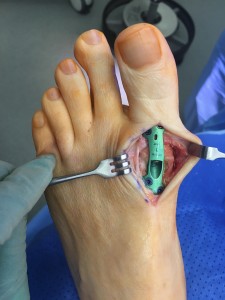 The toes are complex in structure, made of bones and joints. The bones are connected to metatarsals by joints. The front of the foot is known as the forefoot and is made of toe bones known as phalanges. The forefoot is responsible for supporting half of the body weight, it controls your stand, walk, and jump. The muscles allow the toes to move and control how the foot hits the ground, makes it flexible and cushion the impact on the foot. The decision to undergo toe surgery is made when the symptoms are bad, painful, and are affecting your life, and do not respond to other non-surgical treatments. Some of the toe surgical options include bunion surgery, toe fusion surgery, hammertoe surgery, and big toe surgery.
The toes are complex in structure, made of bones and joints. The bones are connected to metatarsals by joints. The front of the foot is known as the forefoot and is made of toe bones known as phalanges. The forefoot is responsible for supporting half of the body weight, it controls your stand, walk, and jump. The muscles allow the toes to move and control how the foot hits the ground, makes it flexible and cushion the impact on the foot. The decision to undergo toe surgery is made when the symptoms are bad, painful, and are affecting your life, and do not respond to other non-surgical treatments. Some of the toe surgical options include bunion surgery, toe fusion surgery, hammertoe surgery, and big toe surgery.
Toe Fusion Surgery
Toe fusion surgery is a procedure meant to straighten the joints of the toe. This surgery is performed on big or small toe deformities such as claw toe, mallet toe, and hammertoe. The surgery is done under general anesthesia and a clip or metal wire is placed inside to fix or straighten the toe. After surgery, the wound is bandaged and the podiatrist will discuss a suitable rehabilitation program for you.
Hammertoe Surgery
When non-surgical treatments fail, hammertoe surgery is an effective method to treat the condition. When the toe abnormally bends, it becomes painful do not immediately consider surgery as an option. First, change to wide-toe box shoes to prevent calluses and corns from forming on the hammertoe. Maintain flexibility on the toes by taking minutes daily to work on toe exercises. Use wearable devices when sitting or sleeping for a long time. The existing surgical procedure uses screws and rods that do not permanently stick out to hold the toe in a reliable and stable position. The podiatrist may cut or move the bones and joints to straighten the toe too.
Bunion Surgery
A bunion is a bump of soft tissue and bone located on the first joint of the big or small toe. Bunions are painful, especially because of the pressure from the footwear. A bunionectomy is a bunion surgery done if the pain limits your ability to conduct everyday activities, ability to walk, and ability to wear closed shoes. The surgery’s main goal is to relieve pain and realign the joint. Bunion surgical options can be to remove the damaged joint, to realign and cut the joint. Your podiatrist will help you decide the best surgery for your bunion.
Metatarsal Surgery
The metatarsals connect the toes to the foot. Metatarsal surgery is done to fix a dislocated or deformed toe. The surgery involves shortening of the bones by cutting. The surgery also relieves pain in the ball of the foot.
Big Toe Surgery
Big toe surgery is also known as cheilectomy, which removes excess bone from the joint of the big toe. It is recommended for moderate damage from osteoarthritis or hallux rigidus. It is performed to provide relief from stiffness and pain. It is also recommended if non-surgical treatments such as shoe modifications, injectable corticosteroids, and non-steroidal anti-inflammatory drugs fail. The procedure is performed while under anesthesia or local anesthesia that numbs just the toe area. Once the excess bones and buildups, such as damaged cartilage or loose bone fragments, the openings made are closed using dissolving stitches. Then the toe is bandaged, use crutches and special protective shoes during recovery.
Foot surgery is sometimes necessary to treat a foot condition. To learn more, contact our podiatrist Ejodamen Shobowale, DPM of DeNiel Foot and Ankle Center. Our doctor will assist you with all of your foot and ankle issues.
Related Posts
No related posts.